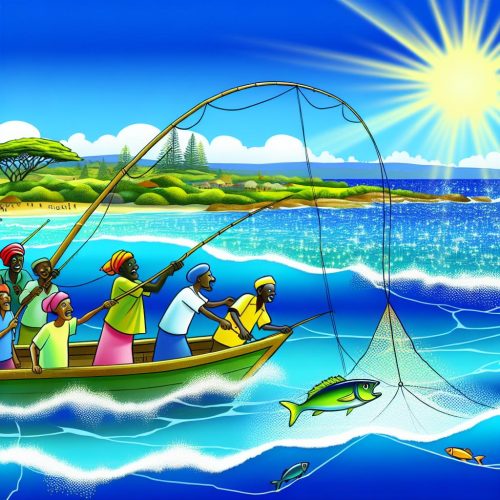Introduction to Deep-Sea Fishing in Kenya
Deep-sea fishing is a prominent activity along Kenya’s coastline, offering both commercial and recreational opportunities. Conducted in the expansive Indian Ocean, this form of fishing takes place beyond the continental shelf where water depths exceed 30 meters. Kenya’s coastline, stretching approximately 536 kilometers, provides a unique marine ecosystem that thrives under distinct environmental conditions. This article delves into the intricacies of deep-sea fishing in Kenya, exploring key fishing areas, the diverse marine biodiversity present, the techniques employed, regulations and conservation efforts, and the economic impact of this activity.
Key Fishing Areas
Kenya’s coastal waters feature several prominent deep-sea fishing locations. These areas are highly regarded for their rich marine life, making them perfect spots for both amateur and professional anglers.
Malindi
Malindi stands out as a top fishing destination due to its proximity to deep waters rich in fish species. The region is particularly known for its abundance of marlin, sailfish, and tuna, making it a hotspot for anglers from around the globe. The area’s fishing richness owes much to the blending of warm and cold ocean currents, which create ideal conditions for various species to thrive.
Watamu
Located along Kenya’s beautiful coastline, Watamu offers breathtaking beaches and excellent deep-sea fishing opportunities. This area is renowned for its supply of billfish, including species such as black marlin and swordfish. Watamu’s marine park provides an ideal breeding environment for numerous fish species, contributing to its reputation as a prime fishing locale.
Diani Beach
Diani Beach is both a tourist magnet and a vital site for deep-sea fishing. The oceanic conditions here favor the capture of a wide array of large fish species, including barracuda and kingfish. The beach offers a perfect blend of relaxation and adventure, drawing visitors who appreciate both leisure and sport fishing.
Marine Biodiversity
The depth and nutrient-rich currents of the Indian Ocean off Kenya’s coast significantly enhance its marine biodiversity, making it a popular target for fishing excursions. The diverse range of species found in these waters include:
- Marlin: Marlins are coveted for their size and speed, attracting many sportfishers aiming to land these impressive creatures.
- Sailfish: Known for their remarkable agility and the spirited fight they put up, sailfish are a favorite among anglers.
- Tuna: Various tuna species, such as yellowfin and skipjack, are regularly sought after in these waters.
- Sharks: Numerous shark species, including hammerhead and tiger sharks, are found in Kenyan waters.
Fishing Techniques and Gear
Deep-sea fishing in Kenya employs a variety of techniques tailored to specific conditions and targeted species. Among the popular methods are trolling and bottom fishing.
Trolling involves trailing lines with baited hooks behind a moving boat. This method is effective for catching pelagic species like marlin and sailfish. Meanwhile, bottom fishing focuses on species that inhabit sea floor areas, often using heavy weights to rig baits close to the ocean bottom.
Fishermen and women utilize specialized gear designed to withstand deep-sea conditions, including robust rods, strong reels, and durable lines capable of handling large, powerful fish. For those interested in exploring fishing tours and equipment further, additional resources are available at Sport Fishing Kenya.
Regulation and Conservation Efforts
The sustainability of deep-sea fishing is paramount to maintaining healthy fish stocks. Kenyan authorities, particularly the Kenya Fisheries Service (KeFS), enforce regulations to ensure the industry’s long-term viability. These measures include licensing requirements, size limits, and seasonal restrictions aimed at preventing overfishing.
Furthermore, both local and international conservation organizations are actively engaged in preserving marine habitats. Key efforts include the protection of coral reefs and the promotion of sustainable fishing practices that encourage responsible use of marine resources.
Economic Impact
Deep-sea fishing is a significant contributor to Kenya’s economy. The industry supports local communities through job creation in fisheries, tourism, and seafood processing sectors. Moreover, Kenya’s reputation as a premier fishing destination continues to attract tourists, bolstering the hospitality and service industries. The economic benefits extend beyond fish sales to include increased activity in coastal regions, thus playing a crucial role in national and community economies.
Conclusion
Deep-sea fishing along Kenya’s coast is a vital economic and recreational activity that leverages the country’s abundant marine resources. The ongoing efforts towards sustainable practices and regulatory measures are essential for maintaining the health of this ecosystem and ensuring that fishing remains a viable industry for future generations. Balancing environmental conservation with economic gain highlights the critical importance of managing this natural resource effectively. By safeguarding fish stocks and marine environments today, Kenya ensures that its deep-sea fishing industry will continue to thrive tomorrow.
